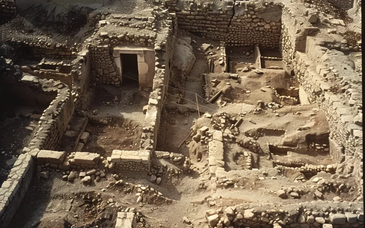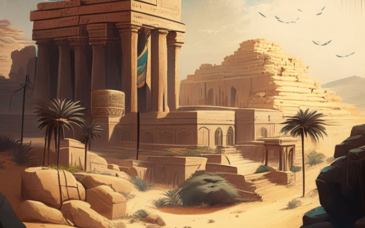
(Note from the Author: Why do a series on Dinosaurs? How does that fit in with Bible Archaeology? - - - I will be the first to admit this is a little off topic, but I do feel it fits into the overall atmosphere of this blog. Perhaps on the fringe, but it does fit in. A great many people have questions about dinosaurs and the Bible, which has led many to the topics covered in these five brief articles. I have attempted to limit these to subjects associated with or somewhat related to archaeological discoveries, or at least claimed discoveries. I, like many, have been aware of these claims for some time and have wanted to write about them but have simply never gotten to them. I decided to get this subject out of my system and publish this series in hopes of providing information some readers will find interesting and hopefully useful. There is a great deal more on this subject available, certainly some more reliable than others, but I believe this series will be the limit of my writings on the subject. I hope you enjoy and as always I encourage your feedback and comments on this any all subjects covered here. – KM)
Dinosaurs and man, two species separated by as much at 65 million years, two species which inhabited completely different worlds at vastly different times in history. This is what the current text books teach and for many, if not most, it is accepted as fact. There are others who claim this theory is in error, that man and dinosaurs lived much closer to the same time and in fact even co-existed. Furthermore, they claim there is scientific proof of this co-existence which is being kept from the public. Some scientists, it is claimed, know this evidence exists but remain silent to avoid ridicule and banishment from the scientific community. Is there a conspiracy to deceive the general public, or is there evidence to support the claims of a young earth, or at least the claims that dinosaurs and man once co-existed? While some dismiss these claims as unworthy of consideration, the basis of any science is to consider all evidence on its own merit, regardless of how it conforms, or doesn’t conform, to the current way of thinking. It is also critical for any scientific investigation to be open to all possibilities.
In this short series we will look at a number of examples of what some believe to be proof that dinosaurs and man co-existed. This of course is in stark contrast to the current scientific opinion and accepted scientific evidence. If it is possible to prove dinosaurs and man lived at the same time it would greatly alter these opinions and perceptions. It would force the time lines to be adjusted to allow dinosaurs to have lived much more recently than currently believed, or for man to have been on earth much longer than is currently accepted. In either case the theory of evolution would be drastically altered, if not totally destroyed, and much of our current understanding of geology and paleontology would have to be re-examined and re-written. This is exactly what some creationists believe should happen. Regardless of our own personal beliefs, if these claimed examples are looked at objectively will they raise doubts about current scientific thinking? Are they simply misinterpreted items which can be explained scientifically, or are they nothing but complete frauds? To begin, we should first establish our base-line for what would constitute evidence that man and dinosaurs once shared the same world.To set a base line we need to establish that prior to the 1800’s man had no knowledge of dinosaurs. The few fossilized remains which had been discovered were not recognized as dinosaurs. In fact, scientists in the early 1800’s tried to fit the rare finds of fossilized remains with animals they knew of or were still in existence. Only after more of the fossil record was discovered did scientist come to realize they were dealing with something entirely new. In 1841 a British scientist by the name of Richard Owen realized the fossils belonged to a species of animals which no longer existed and named this new group, “Dinosauria”. This tells us man has known about dinosaurs for approximately 170 years. This is a very important number in regards to our first examination of archaeological artifacts which challenges the theory dinosaurs and man never co-existed. If fossils were not being gathered and assembled prior to the mid 1840’s, there is no way anyone before that time should have had any knowledge of dinosaurs, and more importantly they should have had no idea what any of these animals looked like. If pictures, drawings or carvings of dinosaurs could be found which pre-date the 1840’s (considerably pre-date) then this could be considered evidence man had somehow seen a dinosaur. This leads to the question, how could ancient man have seen a dinosaur unless he had lived with them? No such drawing or carvings of dinosaurs should exist, yet many believe they do.
Acambaro Figurines - DinosaursThe General Facts: In 1944 a farmer by the name of Waldemar Julsrud was riding his horse when he discovered several small figurines. Curious about the items, Julsrud told local farmers he would pay them for any of the figurines they discovered and brought to him. The farmers soon began bringing Julsrud a wide assortment of figurines. These included figurines of people who appeared to be Egyptians, Sumerians and Caucasians. In addition to the people many of the figurines were of a wide variety of animals, many of which were clearly dinosaurs. Some appeared to be walking on four feet, others were standing on two feet and still others appeared to have fins. In all the farmers brought in over 32,000 figurines. According to various reports, the Director of Archaeology for the Acambaro zone , Carlos Perea, was interviewed regarding the discovery of the figurines. He stated the excavations were unauthorized but surprisingly he said he had no doubt the findings were authentic. Perea said he had examined many of the figurines and was present when a number of them were discovered.
In 1954 the government sent four archaeologists to investigate the claims regarding the figurines. The experts chose a site nearby and began their own excavation. At a depth of approximately six feet they discovered several figurines. While at the site the archeologist declared the figurines to be authentic. Three weeks after the visit the archaeologists reversed this position and declared the figurines to be fraud. There is some debate as to if the archaeologist found new evidence which changed their opinion, or if they succumb to exterior pressures. Which happened depends entirely on who you ask. Key Evidence against Authenticity: The fact the peasant farmers in the area were paid to find these artifacts is a major red flag. It takes very little to imagine just how valuable this source of income could have been to these farmers. Even if they were paid only fifty cents per item (A large sum in 1944) they would have earned over $16,000 for these artifacts. How much money was $16,000 to a peasant farmer in Mexico in the 1940’s? Enough to motivate them to find as many artifacts as possible, or just possibly to create as many artifacts as possible. Given the fact these poor people were being paid by the piece it should not be surprising they turned in some 32,000 rare artifacts.
This brings us to the second issue with the authenticity of these items. The sheer number of artifacts recovered is amazing. Perhaps the ancient people of this region were very prolific in their production of small figurines, but the fact over 32,000 of these figurines survived and could be found cast a great deal of doubt on their authenticity. Perhaps, just perhaps, the money paid to the farmers motivated them to work hard at finding vast quantities of figurines. Possible, but considered highly unlikely by most experts who believe the figurines were crafted by the farmers, buried, and then recovered.
Another major concern with the figurines is the condition in which they were discovered. Most were intact and even those that were broken had most if not all the pieces available. If these figurines had been buried for thousands or even hundreds of years they should not have been in such good condition. While it is not unheard of to find an artifact in remarkable condition, it is the exception, and to find 32,000 artifacts in good condition is more than remarkable. The fact so few were broken or so few partial pieces were found is a major stumbling block. With this many intact figurines you should expect to find a large number broken with large numbers of pieces missing. This is not the case.Key Evidence Supporting Authenticity: The only true evidence these items have to indicate they are authentic is the testing done to determine their age. Several tests were reportedly conducted and several indicated the figurines were very old, in fact ancient. The problem here is that some of these tests were conducted while the testing methods were still suspect and less than reliable. Other tests are reported, but lack supporting documentation. Perhaps the best thing in favor of the figurines being authentic is the reported tests done sometime around 1997. In an attempt to disprove the authenticity of the figurines two samples were sent to a laboratory for independent C14 testing. One figurine was that of a human, the second of a dinosaur. The tests results were announced on a B.C. Video "Jurassic Art”. The human figurine was found to be 4,000 years old. The dinosaur figurine was found to be 1,500 years old. The program claimed the human figurine as authentic, but said the second figurine must have had a faulty test.
These results, if true, bring up two very important points. If the tests results are accurate, does the fact the human figurine is 4,000 years old offer support for the other items in question? Did the farmers find truly ancient figurines and added additional items with these? Secondly, while the test showed the dinosaur figurine to be much younger, the date of 1,500 years places it nearly 1300 years before anyone should have known what a dinosaur looked like. There were claims made the test must have been faulty, but was this simply because the results did not give the expected results, or was there evidence of a mistake during the process? These are questions we do not have the answers too but are critical in the evaluation of these potentially ancient artifacts. Are these tests conclusive proof of the authenticity of the figurines? No, they are not. The reported tests offer some tantalizing hints at authenticity, but the actual documentation of the test are not readily available and thus highly suspect. If the tests are true, and could ever be confirmed or duplicated, it would certainly put these figurines back in the spotlight in a very important way. Conclusions:As pointed out there are ‘reports’ of testing done which would seem to indicate these are true ancient artifacts. There is also considerable doubt as to the origin and true age of these items which is so significant it overrides the poorly documented test results. There are too many areas of suspicion and doubt for these to be considered authentic. This could change if better test results are made available or if additional testing is conducted, but for now I consider this to be an interesting story to follow, but the figurines have a very long way to go before being considered proof that man and dinosaur ever co-existed.
In the second installment of this series we will look at a similar case, but in this case the dates of the carvings are not in question, but are the carvings of a dinosaur, or something else.




